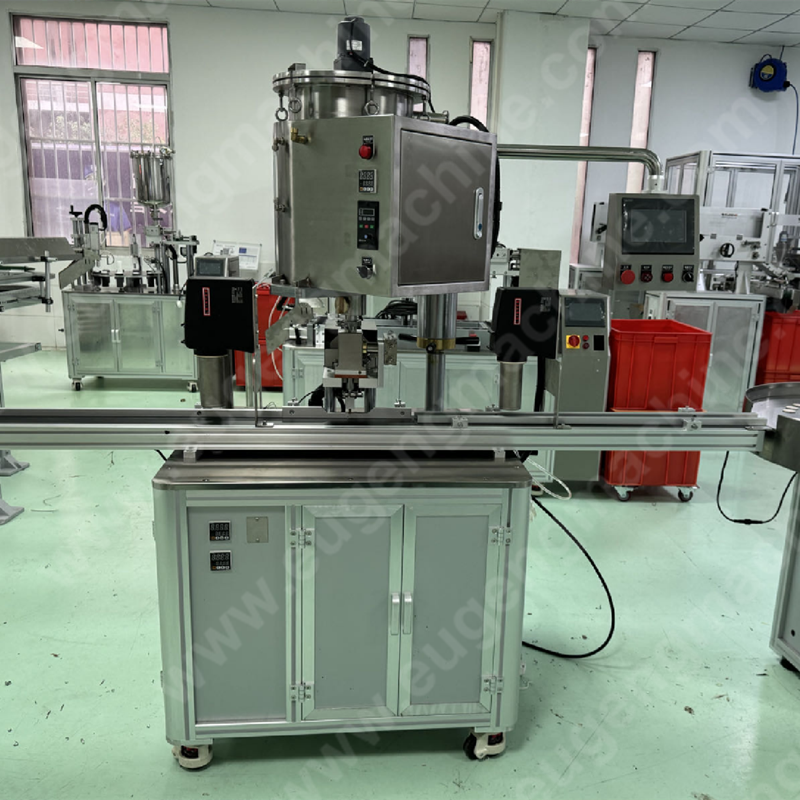A forró töltési folyamat döntő szerepet játszik az elfogyasztott termékek minőségének biztosításában. Magas hőmérséklet használatával sterilizálja mind a terméket, mind a tartályát. Ez a módszer kiküszöböli a káros baktériumokat, így biztonságban tartja ételeit és italait. Ezenkívül segít meghosszabbítani az eltarthatóságot, csökkentve a romlást és a hulladékot. Ezenkívül ez az eljárás megőrzi a természetes ízeket és tápanyagokat, így élvezheti a friss ízű és tápláló termékeket. A biztonság és a minőség fenntartásának képességével ez a technika elengedhetetlenné vált a modern élelmiszer- és italgyártásban.
A melegtöltési folyamat megértése
Mi a forró töltési folyamat?
A melegtöltési eljárás folyékony vagy félfolyékony termékek csomagolására szolgál. Ez magában foglalja a termék magas hőmérsékletre, általában 185 °F és 212 °F közötti melegítését. Ez a hő eltávolítja a káros mikroorganizmusokat, amelyek tönkretehetik a terméket vagy egészségügyi kockázatot jelenthetnek. Felmelegítés után a terméket még forrón sterilizált edényekbe öntik. A termék hője a tartályt is sterilizálja, így biztonságos és szennyeződésmentes környezetet biztosít. Lezárás után a tartályokat lehűtik a termék stabilizálása és minőségének megőrzése érdekében. Ezt az eljárást széles körben használják olyan iparágakban, mint az élelmiszer-, ital- és gyógyszeripar a biztonság és az eltarthatóság meghosszabbítása érdekében.
Miért fontos a forró töltési folyamat?
A forró töltési folyamat létfontosságú szerepet játszik a termékek minőségének és biztonságának megőrzésében. Magas hőmérséklet használatával megakadályozza a szennyeződést, és biztosítja, hogy a termék mentes maradjon a káros baktériumoktól. Ez a módszer a termékek eltarthatóságát is meghosszabbítja, csökkentve a romlás esélyét. Előnyös lesz azokból a termékekből, amelyek tovább frissek maradnak mesterséges tartósítószerek nélkül. Ezenkívül az eljárás segít megőrizni a termék természetes ízeit és tápanyagait. Ez azt jelenti, hogy élvezheti a jobb ízű és tápértéküket megőrző termékeket. A gyártók számára egyenletes minőséget biztosít, és bizalmat épít az Önhöz hasonló fogyasztókkal.
A melegtöltési folyamat legfontosabb lépései
Termék előkészítés
A forró töltési folyamat első lépése a termék előkészítése. Győződjön meg arról, hogy az összetevők tiszták és szennyeződésektől mentesek. Ez a lépés gyakran magában foglalja a nyersanyagok mosását, hámozását vagy darabolását a kívánt állag elérése érdekében. Folyékony termékek esetén keverheti vagy keverheti az összetevőket, hogy egységes állagot hozzon létre. A megfelelő előkészítés biztosítja, hogy a termék készen álljon a melegítésre és a sterilizálásra. Ha erre a lépésre összpontosít, hozzájárul a végtermék minőségének és biztonságának fenntartásához.
Fűtés és sterilizálás
A melegítés és a sterilizálás kritikus fontosságú a forró töltési folyamatban. A terméket magas hőmérsékletre, jellemzően 185°F és 212°F közé melegíti. Ez a hőmérséklet hatékonyan elpusztítja a káros mikroorganizmusokat, amelyek tönkretehetik a terméket vagy egészségügyi kockázatot jelenthetnek. A hő maga a termék sterilizálását is aktiválja. Ezzel biztosítja, hogy a termék fogyasztása biztonságos maradjon. Ez a lépés elengedhetetlen az eltarthatósági idő meghosszabbításához, valamint a termék természetes ízeinek és tápanyagainak megőrzéséhez.
Feltöltés és lezárás
A termék felmelegítése után a töltési és lezárási szakaszba lép. Öntse a forró terméket sterilizált edényekbe. A termék hője tovább sterilizálja a tartályt, így szennyeződésmentes környezetet teremt. Feltöltés után azonnal zárja le a tartályokat, hogy elkerülje a levegő vagy a baktériumok hatását. Ez a lépés rögzíti a termék frissességét és minőségét. A megfelelő lezárás biztosítja, hogy a termék biztonságos maradjon, és megőrizze sértetlenségét a tárolás és szállítás során.
Hűtés és stabilizálás
A hűtés és a stabilizálás a forró töltési folyamat utolsó lépései. Lezárás után a megtöltött edényeket azonnal le kell hűteni a termék minőségének megőrzése érdekében. A gyors hűtés megakadályozza a hosszan tartó magas hőmérsékletnek való kitettséget, ami ronthatja a termék ízét, állagát vagy tápértékét. A hőmérséklet gyors csökkentésével hozzájárul a termék sértetlenségének megőrzéséhez, és biztosítja, hogy fogyasztása biztonságos maradjon.
A hűtést különféle módszerekkel érheti el, például vízfürdőkkel vagy léghűtési rendszerekkel. A vízfürdők hideg vízbe merítik a tartályokat, így hatékonyan csökkentik a hőmérsékletüket. A léghűtés szabályozott légáramlást használ a hő fokozatos csökkentésére. Mindkét módszer célja a termék stabilizálása, miközben megóvja a hősokktól, amely károsíthatja a tartályt vagy a tömítését.
A stabilizálás biztosítja, hogy a termék konzisztens állapotot érjen el a tárolás vagy elosztás előtt. Ez a lépés minimálisra csökkenti a károsodás kockázatát a szállítás vagy a boltok polcain ülve. A megfelelő hűtésre és stabilizálásra összpontosítva garantálja, hogy a termék megőrzi frissességét, biztonságát és általános minőségét, amikor a fogyasztóhoz érkezik.
Hogyan biztosítja a forró töltési folyamat a termék minőségét
A szennyeződés megelőzése
A forró töltési folyamat kritikus szerepet játszik abban, hogy termékei szennyeződéstől mentesek legyenek. A termék magas hőmérsékletre való melegítésével eltávolítja a káros mikroorganizmusokat, amelyek veszélyeztethetik a biztonságot. Amikor a felmelegített terméket sterilizált edényekbe tölti, a hő tovább sterilizálja magát a tartályt. Ez a kettős sterilizálás biztosítja, hogy egyetlen baktérium vagy kórokozó sem él túl. A tartály azonnali lezárása a töltés után biztonságos környezetet teremt, megakadályozva a levegőnek vagy külső szennyeződéseknek való kitettséget. Ez a módszer garantálja, hogy az Ön által fogyasztott termék biztonságos és szennyezetlen marad.
Az eltarthatósági idő meghosszabbítása
A forró töltési eljárásnak köszönhetően a hosszabb eltarthatóságú termékek előnyeit élvezheti. A folyamat során alkalmazott magas hőmérséklet elpusztítja a romló szervezeteket, amelyek az élelmiszerek és italok romlásának elsődleges okai. Ezen organizmusok nélkül a termék hosszabb ideig friss marad. Ez azt jelenti, hogy tovább tárolhatja a tárgyakat anélkül, hogy aggódnia kellene a romlás miatt. A gyártók mellőzik a mesterséges tartósítószerek használatát is, hiszen maga az eljárás természetes védelmet nyújt. Ez a megközelítés nemcsak csökkenti a hulladék mennyiségét, hanem azt is biztosítja, hogy olyan termékeket kapjon, amelyek idővel megőrzik minőségüket.
Ízek és tápanyagok megőrzése
A forró töltési folyamat segít megőrizni kedvenc termékei természetes ízeit és tápanyagait. A termék szabályozott hőmérsékleten történő melegítése biztosítja, hogy az alapvető vitaminok és ásványi anyagok érintetlenek maradjanak. A lezárás utáni gyors hűtés megakadályozza a hosszan tartó hőhatást, amely ronthatja a termék ízét vagy tápértékét. Ez a gondos egyensúly lehetővé teszi, hogy élvezze a friss ízű és egészségügyi előnyeiket megőrző termékeket. Legyen szó gyümölcsléről vagy szószról, a folyamat biztosítja, hogy a végtermék ízt és tápanyagot is biztosítson.
A csomagolóanyagok szerepe a melegtöltési folyamatban
A csomagolóanyagok létfontosságú szerepet játszanak a melegtöltési folyamat sikerében. Biztosítják, hogy a termék biztonságos, friss és kiváló minőségű maradjon a gyártástól a fogyasztásig. A megfelelő anyagok kiválasztása befolyásolja, hogy a termék mennyire ellenáll a folyamatnak, és mennyire tartja sértetlenségét az idő múlásával.
Kompatibilitás magas hőmérséklettel
Olyan csomagolóanyagokat kell kiválasztani, amelyek elviselik a forró töltési folyamat magas hőmérsékletét. A 185°F és 212°F közötti hőmérsékletre melegített termék közvetlenül érintkezik a tárolóedénnyel. Általában olyan anyagokat használnak, mint a PET (polietilén-tereftalát) vagy az üveg, mert ilyen körülmények között ellenállnak a vetemedésnek, olvadásnak vagy törésnek. Ezek az anyagok megtartják formájukat és szerkezetüket, biztosítva a tartály működőképességét.
A hőálló anyagok használata megakadályozza a termék és a csomagolás közötti kémiai reakciókat is. Egyes anyagok magas hőhatásnak kitéve káros anyagokat bocsáthatnak ki. A kompatibilis opciók kiválasztásával biztosítja, hogy a termék biztonságos és szennyeződésmentes maradjon. Ez a lépés elengedhetetlen a termék minőségének megőrzéséhez és a fogyasztók egészségének védelméhez.
A termék integritásának biztosítása
A csomagolóanyagoknak a tárolás és szállítás során is meg kell védeniük a termék sértetlenségét. A tartályokat a megtöltés után szorosan zárják le, hogy elkerüljék a szivárgást vagy a levegőnek való kitettséget. A biztonságos tömítés frissen és szennyeződésmentesen tartja a terméket. Az olyan anyagok, mint az üveg vagy a kiváló minőségű műanyagok tartósságot biztosítanak, biztosítva, hogy a tartály nyomás alatt ne repedjen meg vagy törjön el.
A csomagolásnak védenie kell a terméket olyan külső tényezőktől is, mint a fény, a nedvesség vagy az oxigén. Ezek az elemek ronthatják a termék ízét, állagát vagy tápértékét. Például az átlátszatlan vagy UV-álló anyagok segítenek blokkolni a fényt, ami bizonyos termékekben romlást okozhat. A megfelelő anyagok használatával Ön biztosítja, hogy a termék a lehető legjobb állapotban jusson el a fogyasztókhoz.
Ezenkívül a csomagolás kialakításának igazodnia kell a melegtöltési folyamat hűtési fázisához. Az anyagoknak ellenállniuk kell a gyors hőmérséklet-változásoknak anélkül, hogy elveszítenék szerkezeti integritásukat. Ez biztosítja, hogy a termék stabil és biztonságos maradjon a teljes folyamat során.
A forró töltési folyamat biztosítja az Ön által fogyasztott termékek minőségét. Sterilizálja mind a terméket, mind a tárolóedényét, távol tartja a káros baktériumokat. Ez a módszer meghosszabbítja az eltarthatósági időt, így hosszabb ideig élvezheti a friss és biztonságos termékeket. A hőmérséklet pontos szabályozásával megőrzi a természetes ízeket és tápanyagokat. Az ehhez a folyamathoz tervezett csomagolóanyagok védik a termék sértetlenségét tárolás és szállítás során. Ezekkel az intézkedésekkel biztonságos, ízletes és tápláló termékeket kap, amelyek megfelelnek a legmagasabb minőségi követelményeknek.
GYIK
Milyen típusú termékek számára előnyös a melegtöltési eljárás?
A forró töltési eljárás folyékony vagy félfolyékony termékek esetén működik a legjobban. Általában gyümölcslevekhez, szószokhoz, lekvárokhoz és tejalapú italokhoz használják. Bizonyos gyógyszerészeti és kozmetikai termékeknél is hatásos. Ezeket az elemeket sterilizálni kell a biztonság és a minőség megőrzése érdekében.
A forró töltési eljárás megszüntetheti a tartósítószerek szükségességét?
Igen, a forró töltési eljárás gyakran szükségtelenné teszi a mesterséges tartósítószereket. Azáltal, hogy magas hőmérsékletet használ a káros mikroorganizmusok elpusztítására, természetesen meghosszabbítja a termékek eltarthatóságát. Így élvezheti a hozzáadott vegyi anyagoktól mentes tárgyakat, miközben biztonságosak és frissek.
Hogyan befolyásolja a forró töltési folyamat a termékek ízét?
Az eljárás megőrzi a termékek természetes ízét. A szabályozott hőmérsékleten történő melegítés biztosítja, hogy az íz sértetlen maradjon. A lezárás utáni gyors hűtés megakadályozza a hosszan tartó hőhatást, ami megváltoztathatja az ízt. Friss és autentikus ízű termékeket kap.
A melegtöltési eljárás környezetbarát?
A melegtöltési folyamat környezetbarát lehet, ha fenntartható csomagolóanyagokkal párosul. A tartósítószerek szükségességének csökkentésével és az eltarthatóság meghosszabbításával minimálisra csökkenti az élelmiszer-pazarlást. Az újrahasznosítható anyagok, például az üveg vagy a PET használata tovább fokozza környezetbarát jellegét.
Mely csomagolóanyagok a legalkalmasabbak forró töltéshez?
Olyan anyagokat kell használni, amelyek ellenállnak a magas hőmérsékletnek anélkül, hogy deformálódnának vagy káros anyagokat bocsátanának ki. A gyakori lehetőségek közé tartozik a PET (polietilén-tereftalát) és az üveg. Ezek az anyagok a folyamat során megőrzik szerkezetüket és védik a termék minőségét.
Működik a forró töltési eljárás szénsavas italoknál?
Nem, a forró töltési eljárás nem alkalmas szénsavas italokhoz. A magas hőmérséklet hatására a szénsavasodás kiszökhet, ami lapos italokhoz vezethet. A szénsavas termékeknél a gyártók jellemzően hidegtöltést vagy más speciális módszereket alkalmaznak.
Hogyan hasonlítható össze a meleg töltés a hideg töltéssel?
A forró töltés magas hőmérsékletet használ a termékek és tartályok sterilizálására, így biztosítva a biztonságot és a meghosszabbított eltarthatóságot. A hidegtöltés viszont a hűtésre és a tartósítószerekre támaszkodik a minőség megőrzése érdekében. A melegtöltés természetesebb megközelítést kínál, míg a hideg töltés olyan termékekhez illik, amelyek nem bírják a hőt.
Vannak korlátai a melegtöltési folyamatnak?
Igen, a folyamatnak vannak korlátai. Előfordulhat, hogy nem működik jól a hőérzékeny termékeknél, mivel a magas hőmérséklet leronthat bizonyos összetevőket. Ezenkívül speciális csomagolóanyagokra van szükség, amelyek képesek kezelni a hőt, ami növelheti a termelési költségeket.
Mennyi ideig hosszabbítja meg az eltarthatóságot a forró töltési folyamat?
A forró töltési folyamat jelentősen meghosszabbítja az eltarthatósági időt a romló szervezetek eltávolításával. A terméktől függően az eltarthatósági idő több hónappal megnőhet. Ez ideálissá teszi azokat a tárgyakat, amelyeknek hosszú ideig frissnek kell maradniuk.
Biztonságos a melegtöltési eljárás a fogyasztók számára?
Teljesen. Az eljárás a termék és a tartályának sterilizálásával biztosítja a biztonságot. Megszünteti a káros baktériumokat és kórokozókat, így nyugalmat biztosít a termék fogyasztása során. A megfelelő lezárás és csomagolás tovább növeli biztonságát.
Tartalom:
- A melegtöltési folyamat megértése
- A melegtöltési folyamat legfontosabb lépései
- Hogyan biztosítja a forró töltési folyamat a termék minőségét
- A csomagolóanyagok szerepe a melegtöltési folyamatban
-
GYIK
- Milyen típusú termékek számára előnyös a melegtöltési eljárás?
- A forró töltési eljárás megszüntetheti a tartósítószerek szükségességét?
- Hogyan befolyásolja a forró töltési folyamat a termékek ízét?
- A melegtöltési eljárás környezetbarát?
- Mely csomagolóanyagok a legalkalmasabbak forró töltéshez?
- Működik a forró töltési eljárás szénsavas italoknál?
- Hogyan hasonlítható össze a meleg töltés a hideg töltéssel?
- Vannak korlátai a melegtöltési folyamatnak?
- Mennyi ideig hosszabbítja meg az eltarthatóságot a forró töltési folyamat?
- Biztonságos a melegtöltési eljárás a fogyasztók számára?

 EN
EN
 AR
AR BG
BG HR
HR CS
CS DA
DA NL
NL FI
FI FR
FR DE
DE EL
EL HI
HI IT
IT JA
JA KO
KO NO
NO PL
PL PT
PT RO
RO RU
RU ES
ES SV
SV TL
TL IW
IW ID
ID LV
LV LT
LT SR
SR UK
UK VI
VI HU
HU TH
TH TR
TR FA
FA MS
MS UR
UR BN
BN LO
LO LA
LA PA
PA
